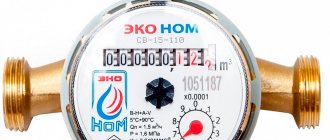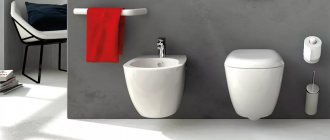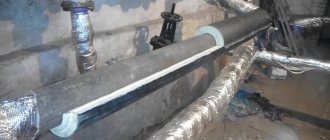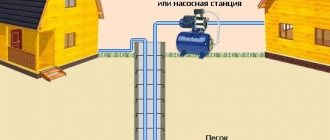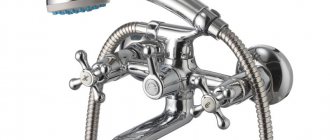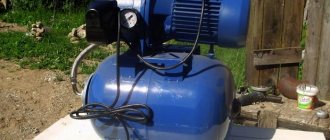Autonomous water supply for a country house is extremely convenient! There is complete independence from the “whims” of public utilities; the volume and quality of water supplied depends entirely on the owners. More precisely, from how competently, fully and conscientiously they created the entire system, from taking water from the source and going through the entire necessary preparation cycle - and to the final supply at the points of consumption under the required pressure.
Cold water expansion tank
It is clear that supplying water directly, that is, turning on the pump every time you just need to rinse your hands or fill the kettle, is an extremely irrational solution. Believe me, no matter how high-quality the pump is, it will not withstand such “killer” operation for long. This means that some kind of intermediate link in the system is needed in which ready-to-use water will be accumulated - from there it will go to the consumer. And only as it is consumed, the pump will sometimes turn on to replenish the created reserve and create the necessary pressure in the pipes.
This intermediate link is precisely the expansion tank for cold water, or, as it is often called, a hydraulic accumulator. Without this simple device, in principle, an autonomous water supply system will never become complete.
Purpose
Most substances used to transfer thermal energy are a neutral, slightly compressible liquid medium. That is why when using it, the presence of stabilization devices is required - expansion tanks with a membrane. Such units accept part of the liquid when it increases in volume when heated, and also return it back to the circuit when the temperature decreases.
When the temperature of the coolant increases, the water pressure in the system increases. Due to the inability of the heat carrier to compress and the tightness of the installation as a whole, pipes and boilers often fail.
In this situation, it is a mistake to think that the problem can be solved solely by installing a special valve that allows you to displace excess filling material during the heating period. As the liquid cools, it will decrease in volume and air will take its place. The air gap will begin to impede the circulation of the liquid medium. In order to eliminate this nuisance, you will have to systematically drain the excess and supplement the circuit with new coolant, as well as heat it. Which, in itself, will not be cheap.
To avoid such difficulties, you should install a membrane expansion tank, which is a special tank connected to the system through a pipe. Excess pressure in it will be neutralized due to the dynamics of volume indicators and the network will be able to operate stably.
Popular tank manufacturers
1. Wester heating tanks are recognized as one of the best in Russia for home use. The domestic manufacturer produces vertical and horizontal models with a volume ranging from 8 to 500 liters. Their rubber is made of especially durable heat-resistant material that can withstand heating up to 100 °C. Plus, the expansion tank is equipped with a replaceable membrane, which increases its service life.
The body is made of durable steel. The heaviest barrels are equipped with supports. The warranty covers 3 years. The price of the Wester WRV 80, the most popular model, is about 2,500 rubles.
2. The next interesting brand is Reflex from a German manufacturer. It is characterized by high strength and long service life - up to 12 years. The Reflex expansion tank for heating of any model is made using the famous technology of the Krupp dynasty, famous for its high-quality steel.
Volumes are very different: from 8 to 1,000 liters. The tank is equipped with a replaceable membrane designed for temperatures up to 70 °C. The cost of this line starts from 1,520 rubles.
3. A series of Chinese manufacturer Zilmet CAL-PRO is very often found on sale. Tanks with capacities from 4 to 900 liters are offered on the market. Their body, made of carbon steel, is either ringed or welded. The membrane is made of synthetic rubber. The device can operate at temperatures from – 10 to 100 °C.
The cost of a membrane expansion tank of the CAL-PRO series for heating starts from 1,170.
How to choose for your home
When heated to 70-90 °C, all water increases in volume by 4-5%. Without a buffer, it creates high pressure in the pipes, which can cause them to burst. Therefore, the correct choice of a membrane tank for a heating system is very important. It should be done on the basis that the expander must take on all the excess volume of liquid. Therefore, before purchasing, it is necessary to correctly calculate this amount, and even better, consult with the designers.
It is also advisable to ensure that the tank is made of high-quality materials, otherwise it simply will not withstand the loads.
Very often, inexperienced or unscrupulous sales consultants try to sell clients devices intended for water supply instead of the required ones, believing that there is practically no difference between them, except perhaps in color (blue and red). In fact, hydraulic accumulators are used in heating systems only due to oversight. In this case, since their rubber is not designed to withstand heat, they quickly fail.
Brief DIY installation instructions
- First you need to decide on the location of the device. According to the instructions, the expansion tank can be installed anywhere in the heating system, but in order to avoid sudden pressure surges, it is better to place it immediately behind the circulation pump.
- The device must be installed so that there is access to the air valve, drain valve, shut-off valves and other important parts.
- During installation, the room must not be below 0 °C. The safety valve must be installed along the flow direction.
- There is nothing complicated in the installation itself, you just need to follow the instructions and use the proper tools, in particular a wrench for metal-plastic pipes and connectors. The pipe must match the pipeline.
- Tanks with a large capacity must be mounted on additional brackets. To do this, first mark the location, then drill a hole and attach the hangers with anchor bolts.
- After the equipment is secured, a pipe is connected to it so that it does not interfere or put pressure on the tank.
- Then a pressure reducer is installed; it must be installed after the meter.
- If everything is done correctly, you can start setting up - pump in air and water, observing the pressure. When it is balanced, you can start turning on the heating.
- It is better to entrust the installation of a tank in a multi-boiler system to specialists who have been tested and received the appropriate license.
Prices in Moscow
You can buy a membrane expansion tank at the estimated cost indicated in the table.
| Brand | Cost, rubles | |||||||||||
| Volume, l | 8 | 12 | 18 | 24 | 35 | 50 | 80 | 100 | 150 | 200 | 300 | 500 |
| Wester | 790 | 860 | 900 | 1 000 | 1 650 | 1 900 | 2 500 | 3 500 | 5 200 | 9 500 | 11 500 | 18 100 |
| Volume, l | 8 | 12 | 18 | 25 | 33 | 60 | 80 | 100 | 140 | 200 | 300 | 500 |
| Reflex | 1 520 | 1 600 | 1 980 | 2 300 | 3 070 | 4 900 | 5 900 | 6 700 | 9 060 | 10 860 | 15 000 | 23 000 |
| Volume, l | 8 | 12 | 18 | 25 | 35 | 50 | 80 | 105 | 150 | 200 | 250 | 500 |
| Zilmet CAL-PRO | 1 170 | 1 230 | 1 300 | 1 630 | 2 100 | 3 100 | 4 200 | 6 100 | 7 600 | 9 480 | 12 200 | 22 200 |
Advantages and disadvantages
The expansion tank absorbs a certain amount of water as its volume increases, then returns it. The pronounced advantages of such devices should be noted:
- possibility of use for any liquid circulating in water supply and heating complexes, even with excessive calcium content;
- no need to pump in a large amount of air (when compared with tanks operating without a membrane);
- simplicity and comparative cheapness of installation of structures;
- significant savings during operation.
We cannot remain silent about the existing disadvantages of expansion tanks. These include:
- increased likelihood of rust occurring in units;
- increased heat loss due to heat transfer to the hydraulic accumulator;
- Impressive dimensions requiring enough space for installation.
Design features
In residential and industrial premises, heating networks are installed according to open and closed schemes. The first option is more suitable for centralized systems, which allows the liquid to be collected directly for hot supply. In this case, the tank is installed in the upper zone of the circuit. The container makes it possible to control the process of pressure surges by removing air pockets from the pipes.
The second type of installation involves the use of tanks with a membrane. They are distinguished by their comparative simplicity of design. They consist of an expansion tank and a membrane-plate, which, in turn, can be:
- Balloon. This means that the heat carrier is placed inside a rubber cylinder, and on the outside there is nitrogen or air. If this element breaks down, it’s easy to replace; you don’t have to buy a whole new device.
- Diaphragm. Made in the form of a permanent partition made of metal or polymer material. This part has a compact capacity and can neutralize only small pressure surges in the network. If it fails, it is impossible to replace it, as a result of which you will have to purchase another tank. Of course, the cost of this membrane is slightly lower than the above option.
Types of expansion tanks
The expansion tanks used are the main components of water supply devices, heating systems and fire extinguishing devices. There are only a few varieties:
- Diaphragm tank (closed type). It is a metal capsule-container that has the shape of a ball or capsule. Inside it, the space is divided by a membrane, the production of which uses thermal rubber. As a result, two chambers are formed - air and liquid. The air valve should be installed in the air chamber. It will allow some air to be removed at a time when the pressure level is significantly increased. So the liquid fills the entire tank.
- Open type tank. It looks like a container, at the bottom of which there is a special device that is directly connected to the heating device (its pipe). Characteristic features include the ratio of the total volume of liquid in the heating system and that located in the expansion tank. The volume will directly depend on the temperature conditions inside the system. It is recommended to install the tank at the highest point of the heating device (attic). To reduce heat losses, it is possible to use a heat insulator. An open-type tank cannot be called hermetically sealed, which makes it look not very attractive, it is quite bulky, which does not allow installation in residential premises.
How does a membrane expansion tank work?
For any system, the coolant parameters are set in accordance with the recommendations specified in the operating instructions for the unit. The type of membrane-plate does not directly affect the functional features of the device. However, if it belongs to the balloon variety, the reservoir is able to accommodate a larger amount of heat-carrying liquid medium.
MBFT-75 Membrane for 75GPD
SF-mix Clack up to 0.8 m3/h
SF-mix Runxin up to 0.8 m3/h
The principle of operation of the expansion tank does not differ between different designs. When the number of atmospheres increases due to the increase in liquid volume when heated, the membrane stretches. Next, the gas located outside is compressed, which allows the remnants of the liquid medium to penetrate inside. Well, after the pressure decreases due to a decrease in temperature, the reverse process is activated.
Stability of operation is ensured in automatic mode. In order for it to function correctly, it is necessary to select a suitable container and perform preliminary calculations before installation. The required parameters cannot be achieved if the tank is larger or smaller than the required volume. Such a discrepancy can lead to an emergency.
Tips for choosing the best tank
When choosing hydraulic tanks, we are guided by the following considerations:
- A hydraulic accumulator with a replaceable cylinder-type shell has a number of advantages over products with a built-in diaphragm - it allows you to change the cylinder, which is beneficial due to the not too long service life of products made from natural materials. In addition, the water in balloon tanks does not come into contact with its walls - this reduces the requirements for the corrosion resistance of a metal tank.
- It is better to choose a removable flange from durable stainless steel with a long service life.
- The required volume of the hydraulic accumulator is determined using the above formulas; to avoid calculations, you can use ready-made tables.
- The cylinder material in drinking water intake systems is chosen from environmentally friendly food grade rubber; butyl best suits these requirements.
- When purchasing, they consider manufacturers taking into account the optimal price-quality ratio; hydraulic accumulators from Zilmet (a holding company headquartered in Italy), Reflex (Germany) are considered to be among the best; it is clear that in quality indicators they are inferior to Russian-made Gilex and Wester units, Aquasystem Russian assembly from Italian components.
Rice. 15 Cost of popular models of hydraulic accumulators in 2019
A hydraulic accumulator is one of the most important components in an autonomous water supply system, its functioning largely depends on its physical parameters, design and materials of manufacture. To select a suitable unit, determine its required volume using simple formulas or tables, then select a model from a number of brands of domestic and foreign production according to the optimal price-quality ratio, considering the materials of manufacture and being guided by reviews and advice from experts.
Product selection rules
When deciding on a model, you should pay attention not only to the volumetric characteristics. It is equally important that the device meets a number of other requirements:
- the membrane-plate must withstand high temperatures and changes in atmospheric parameters;
- the unit must not deviate from established sanitary and hygienic standards;
- installation features also need to be taken into account when purchasing.
When choosing a device (membrane-type expansion tank), it is easy to notice that today there are many types of tanks on the market, manufactured both in Russia and abroad. The main differences lie in the price range of the products.
Sticking with the cheapest model is definitely not the best decision. After all, a minimum of purchase costs can subsequently result in many problems due to the low quality characteristics of the materials used in production. In this regard, it is worth giving preference to domestic manufacturing companies. The products they produce are in no way inferior in quality to expensive imported products, and are much less affordable. Do not forget that a famous brand does not guarantee the reliability and long service life of the device.
The leading parameter that you should rely on when choosing a tank is its volume. Many experts advise buying an expander with a capacity of 10% of the total amount of coolant in the heating network. The expansion coefficient at maximum temperature conditions must remain within 0.8. Therefore, all required calculations must be carried out with utmost accuracy. And it is necessary to take into account:
- system pressure limit;
- volumetric characteristics of the coolant;
- the initial number of atmospheres in the tank;
- corresponding thermal coefficient.
When deciding on the dimensions of the device, be sure to check the availability of all components. To do this, just carefully review the project documents. If the necessary documentation is missing (lost), the required parameters should be calculated approximately. Just know that 1 kW provides 15 liters of liquid. In high-rise buildings, the coefficient is usually calculated by taking into account the composition of the liquid medium, which often includes glycols, which have a beneficial effect on its quality.
In addition, it is quite possible to determine this value based on the temperature of the coolant. The maximum network pressure is determined using the limit set for the nodes. This is done by setting up special locking elements. The initial number of atmospheres must be minimal. On a number of models it is adjusted by pumping or deflating air. Directly in the tank, control is carried out using a pressure gauge.
The use of an expansion tank with a membrane has its own limitations. The possibility of its use in a given situation is mainly influenced by the production methods used by the manufacturer, as well as the materials. In some situations, special requirements are imposed on the composition of the coolant. Thus, a mandatory reduction in the amount of ethylene glycol or antifreeze may be indicated.
When choosing a suitable product, pay attention to the Russian company -. The products manufactured by the organization meet the highest quality characteristics and are able to serve their owners for a long time. The reliability and high quality of the products are confirmed by the company's many years of experience and many positive reviews from grateful customers.
Open type hydraulic tank
Such designs are considered obsolete, since they do not provide absolute autonomy, and can only increase the period between maintenance. The heated liquid evaporates, and its shortage must be eliminated by periodically adding coolant to replenish its volume. No diaphragms or bulbs are used. Pressure in the system appears due to the fact that the open hydraulic tank is mounted on a hill (in the attic, under the ceiling, etc.).
Naturally, there is no air pressure in an open type expansion tank. When calculating, it is taken into account that one meter of water column creates a pressure of 0.1 atmospheres. However, there is a way to automate water collection. To do this, a float is installed, which, when lowered, opens the tap, and after filling the tank, it rises and blocks the access of water to the tank. But in this case, you still need to monitor the operation of the system.
Types of membrane expanders
To compensate for the volume of coolant in the network at the time of temperature changes, two types of containers are used: open and closed. The first type is very popular among consumers, but has a number of disadvantages:
- installation requires significant costs, since such devices are installed in the upper zone of the system in order to set the required atmospheric parameters;
- it is necessary to constantly monitor the level of the liquid medium;
- there is a possibility of rust due to prolonged contact of water with air.
The second type of expansion tanks is devoid of such disadvantages. Their design provides for the presence of a special membrane (balloon or diaphragm).
AMETHYST - 02 M Residential building for up to 10 people or up to 2 cubic meters/day.
Aeration unit AS-1054 VO-90
Main table dispenser AquaPro 919H/RO (hot and cold water)
Installation Requirements
It is quite possible to install the unit even with your own hands. It is absolutely not necessary to call a specialist for this. The main thing is to strictly follow the installation rules and carry out everything according to the design of the expansion membrane tank.
An expander with a volume of 30 liters or more should not be attached to load-bearing walls. As a rule, large tanks are installed directly on the floor on special steps. During installation, you must ensure that:
- the circumference of the adapter was ¾, and the return had a corresponding thread;
- during the installation process, the structural elements did not interfere with the work;
- no excessive load was placed on the tank;
- you had paronite heat-resistant gaskets at your disposal;
- the container was equipped with a special locking mechanism that allowed the gas pressure to be adjusted.
Calculation of accumulator volume
The selection of a membrane tank is primarily carried out according to its main parameter - volume; if it is small, the system will work ineffectively with too frequent activation of the electric pump and small water hammers. If the volume is exceeded, stagnation of water in the tank can make it undrinkable.
To calculate the volume of the hydraulic tank, use the following formula:
Vt = 16.5 Qmax/A Pmax Pmin/(Pmax – Pmin) 1/Pg, where:
- Vt —hydraulic tank volume;
- Qmax – water supply per unit of time, measured in liters per minute, standard water consumption for one family is 3 m3/hour or 50 l/min;
- A – the permissible number of starts of the electric pump in one hour, depends on the power of the unit, for most submersible models the limit is 20;
- Pmax and Pmin are the values of the switch-off and switch-on pressures of the electric pump in bars, their typical average values are 3 and 1.5 bar, respectively;
- Pg – air pressure inside the accumulator in bars, calculated by multiplying Pmin by 0.9 (0.9 x 1.5) = 1.35.
As a result we get:
Vt = 16.5 50/20 3 1.5/(3 – 1.5) 1/1.35 = 91.66 l
As can be seen from the table in Fig. 10, the maximum volume of water inside any expansion tank does not exceed 50% of its rating data.
Use as a hydraulic accumulator
Thus, the expander is used in water supply systems. Thanks to the unit, it is possible to accumulate a certain amount of liquid and then use it for its intended purpose. It is noteworthy that to organize the supply, the accumulated liquid medium under pressure is used without taking into account the operation of the pumping station. The pump does not have to be turned on too often, which significantly extends its service life.
In addition, the membrane cistern replenishes the expansion of H2O in the hot water supply.
Scheme
Now let's take a closer look at why an expansion tank is needed in a water supply system, using specific diagrams as an example.
Boiler piping
The boiler piping usually includes two fittings installed on its inlet pipe:
| Image | Description |
| Check valve. It passes cold water from the water supply into the storage water heater, but does not allow it to flow back when the hot water supply is turned off. |
| Safety valve. Since the check valve turns the water supply and the boiler into a closed circuit, when the water is heated, the pressure in it begins to quickly increase. When it reaches dangerous levels, the safety valve releases excess water through the drain tube. |
Helpful: Combined check and safety valves in one housing are often sold under the name “boiler safety group.”
Boiler valve
While the volume of the boiler is small, losses of heated water are insignificant or absent (thermal expansion is compensated by the elasticity of the walls of the water supply system). But with its significant volume, hot water is discharged into the drainage in liters and tens of liters, which significantly affects the costs of hot water supply.
Connecting the expansion tank to the water supply system completely eliminates the loss of heated water. Its excess is contained in a membrane tank, which is accompanied by a slight increase in pressure in the circuit.
Diaphragm tank in the boiler trim
How large should the expansion tank be for a water supply system with a boiler of known volume?
Usually it is taken equal to 10% of the boiler volume. Yes, the thermal expansion of water within reasonable temperature limits is less than 10%; however, do not forget that the capacity of the water compartment is not equal to the full volume of the membrane tank: part of this volume is occupied by air.
Therefore, in practice, rounding up is used: an expansion tank for water supply of 50 liters is capable of ensuring the safe operation of a 500-liter boiler.
Expansion of water when heated
Water supply
How to use a hydraulic accumulator or expansion tank for cold water supply, providing yourself with water during periodic outages?
The instructions for installing the device yourself are extremely simple and consist of only two points:
- Connect the tank pipe to any part of the water supply using a flexible or rigid connection;
The hydraulic accumulator will provide you with water during short-term outages
- Install a check valve at the cold water inlet. It will not allow water to drain from the tank into the disconnected and discharged main water supply.
Please note: the useful capacity of the membrane tank differs markedly from its total volume. For example, an expansion tank of a water supply system of 500 liters is capable of storing no more than 250 liters of water in case of a power outage.
Well water
How to install an expansion tank in a water supply system with water supplied from a well or well? It is again mounted at any point in the water supply system.
Membrane tank in an autonomous water supply system
In addition to the membrane tank, such a system includes:
| Image | Description |
| Submersible or surface pump. It raises water and creates excess pressure, which ensures the operation of plumbing fixtures. |
| Check valve. It is placed after a submersible pump or on the suction pipe of a surface pumping station. |
| An automatic relay that controls the operation of the pump (that is, it turns it on when the pressure in the circuit drops and turns it off when the pressure reaches the upper critical value. |
Water supply diagram from a well
What pressure should be maintained in the expansion tank of the water supply system?
The answer cannot be given without knowing the settings of the automatic pump control. The pressure in the water supply expansion tank should be slightly lower (by about 0.2 atmospheres) than the pressure when pumping water from the well. In this case, the pump will start before the remaining water from the membrane tank flows out through the open tap.
How to pump up an expansion tank in a water supply system if the pressure in it has dropped below the required level? This can be done with any air pump - bicycle, car, etc. The pump hose is connected to the spool on the diaphragm reservoir.
Inflating a membrane tank with a car compressor
Water from container
Water supply from a storage tank is practiced in gardening communities with water supply on a schedule, as well as where worn-out water supply lines are often turned off for repairs. The easiest way to supply water to the water supply is by gravity, from a tank installed in the attic.
Gravity water supply with water supplied from a container installed in the attic
However, this scheme has three serious drawbacks:
- The water supply is limited by the strength of the ceiling;
- The attic must be insulated and heated, otherwise the water will freeze in the first frost;
- The pressure in a gravity water supply is limited by the vertical distance between the tank and the tap. Meanwhile, for normal operation of household appliances (instantaneous water heaters, washing machines and dishwashers) a pressure of at least 3 meters (0.3 kgf/cm2) is needed.
Supplying water from a container installed in the basement, underground or ground floor using a pumping station is free of all these disadvantages: the weight of the tank standing on the surface of the soil or screed is not limited in any way, the pressure is created by the pump, and the temperature of the soil below the freezing level is above zero all year round.
A tank with a supply of water is installed in the basement
What role does the expansion tank for water supply systems play in this scheme? The same as when supplying water from a well: it smoothes out pressure surges and allows the pump to idle with little water consumption.
What should be the connection diagram for the expansion tank for water supply? Again, the same as with autonomous water supply from a well or borehole.
Scheme of water supply from the storage tank
However: in practice, a surface pumping station is usually installed to supply water from a tank, which consists of a pump, an automatic relay with a pressure sensor and a hydraulic accumulator on one frame.
In the photo - pumping station
For protection against water hammer
Such a load represents a sharp jump in the speed of water flow, which occurs when the pipeline is unexpectedly blocked. A change in the number of atmospheres, in turn, can cause damage to pipes. In such a situation, the expansion tank acts as a damper: the membrane-partition stretches, which leads to an increase in the volume of the corresponding compartment of the tank, and the pressure decreases.
Installation instructions
When planning to install the device yourself, we must not forget about the need to first study the installation manual in detail. If you do not have the necessary documentation, you should definitely contact the retail outlet where you purchased the product. Otherwise, understanding the nuances of the equipment will be much more difficult. And every mistake will subsequently only result in additional costs.
According to the advisory document included with the device, design changes are not permitted. Repair or installation work may only be carried out by persons who have access to perform a specific activity.
When replacing a failed tank part, you should replace it with only the original. After all, according to the instructions, it is prohibited to use elements of inadequate quality. The installation manual also contains a detailed description of safety precautions that must be strictly adhered to during installation of the unit.
Main table dispenser AquaPro 929CH/RO (cooling/heating)
Floor dispenser AquaPro 311 (empty, without cooling)
Floor-standing dispenser AquaPro 6207CH (cooling/heating/room temp.)
The difference between a tank and a hydraulic accumulator
Despite the similarity in design characteristics, the purpose of the devices is still not the same. The expansion tank compensates for the increase in liquid volume due to heating. A similar device accumulates a liquid medium under pressure, minimizing the number of starts of the pumping station, thereby prolonging its performance.
Also inside the hydraulic accumulator structure there is a special rubber bulb container, thanks to which it is possible to avoid contact of H2O with the walls of the tank. The expander, in contrast, is manufactured together with a membrane designed to divide the body into two compartments. In this case, there is interaction of the coolant with the tank.
Device
How are expansion tanks for water supply arranged?
A membrane tank is a steel container with a pipe for connecting to a water supply or heating system and a spool for pumping. It is divided by an elastic membrane into two compartments - air and water. The air compartment is often filled with nitrogen instead of air, which prevents corrosion from damaging the tank walls.
Construction of a water supply expansion tank: a steel container is divided into two compartments by an elastic membrane
Curious: the expansion tank of a hot water supply or heating system is usually equipped with a membrane with increased heat resistance. There are no other design differences between it and the hydraulic accumulator, so the expansion tank can be safely used as a hydraulic accumulator.
